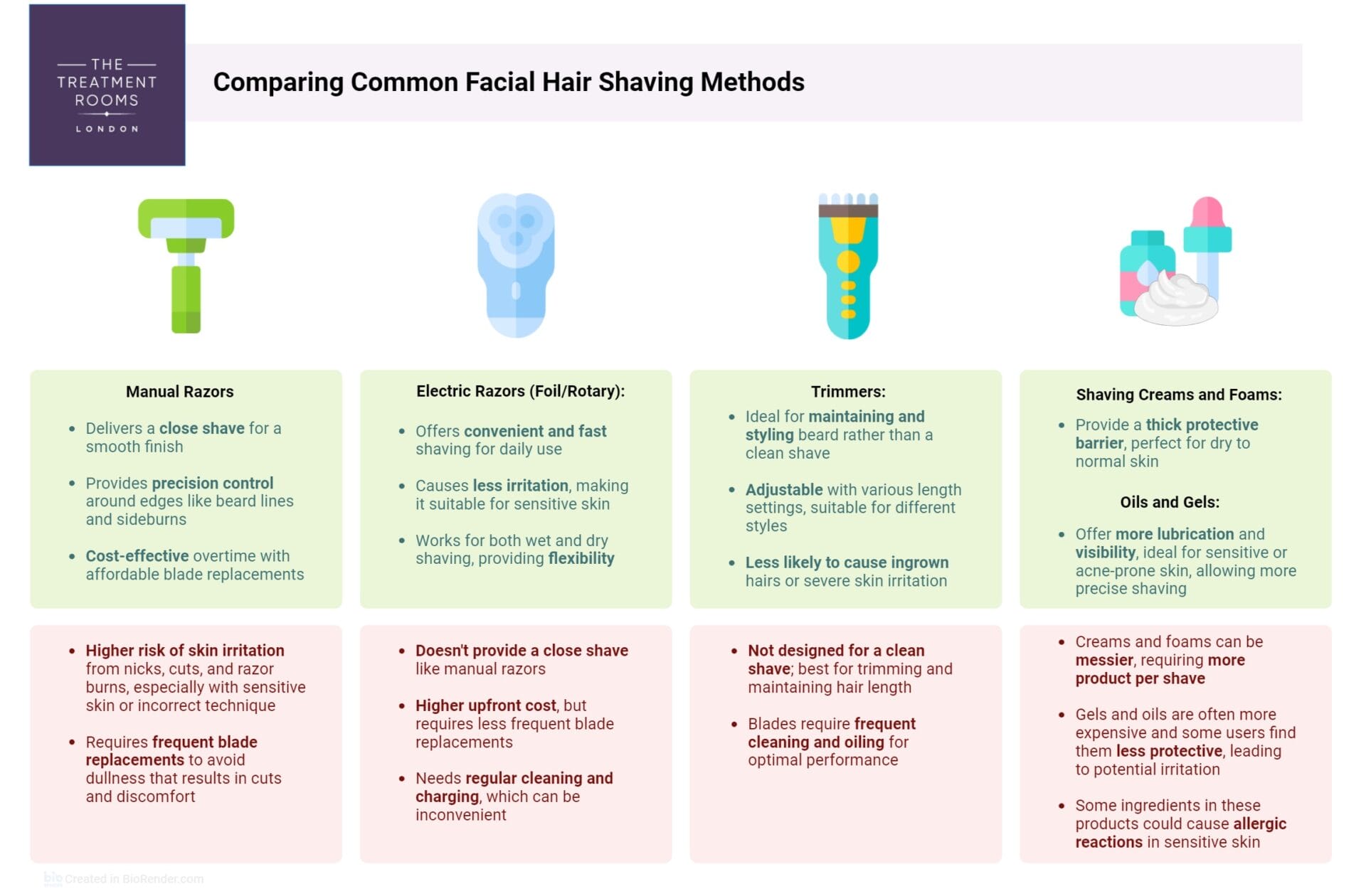Quick Summary: Shaving and Hair Growth Myths
Shaving Myths Debunked: In short, contrary to popular belief, shaving does not cause hair to grow back thicker, darker, or faster. This misconception arises from the blunt feel of stubble following a shave, which is merely a temporary effect.
Research Highlights: Popular studies from 1928 and 1970 on this topic confirm shaving does not affect hair’s thickness or growth rate, aligning with modern dermatological understanding.
Common Shaving Concerns: Proper shaving techniques can prevent issues like razor burn, ingrown hairs, and skin irritation. Using a sharp razor, proper shaving products, and following good skin care practices can minimise these problems.
Healthy Hair Growth Tips: Good hair care includes using the right products, regular scalp and skin care routines, and a nutritious diet. For those experiencing significant hair loss or difficulties growing hair, consulting healthcare professionals is recommended, and our clinic is available for guidance on hair and beard transplants.
Key Takeaway: Shaving is a cosmetic practice without long-term effects on hair growth. For optimal hair health, focus on proper grooming practices and professional advice.
“Does shaving make your hair grow back thicker?” Many of us have heard this claim, but what does science say? In this article, we’ll debunk this popular myth, backed by scientific evidence, and provide helpful tips for maintaining healthy hair and beard growth through proper shaving techniques.
Debunking the Myth
Contrary to popular belief, shaving your hair—whether it’s your beard, head, or body hair—does not cause it to grow back thicker. Here’s why:
The hair shaft grows from a follicle located beneath the skin’s surface, starting with a bulbous base and naturally tapering to a fine tip as it grows and ages. The thickness and shape of each hair is genetically determined and varies from person to person. When you shave, you’re cutting the hair shaft at a relatively thicker point of the strand. As this hair regrows, the cut end may initially appear blunt and feel coarser, giving the illusion of thicker hair.1,2 This is merely a temporary effect. Shaving doesn’t actually alter the hair’s thickness or change its natural growth cycle; the hair follicle and its root, where hair growth begins, remains unaffected.
Understanding Hair Growth: Insights from 1928 and 1970 Studies
Shaving is often believed to affect hair thickness and growth rate. We delve into two significant studies—one from 1928 and another from 1970—to debunk myths and clarify how hair actually responds to shaving.
1928 Study3
- Objective: To explore if shaving affects the rate of hair growth.
- Methodology: Researchers monitored facial hair growth on the left cheek of four men under consistent shaving conditions.
- Results: Hair growth was initially quick but slowed over time, indicating that hair growth naturally decreases the longer it is allowed to grow, aligning with the natural hair growth cycle.
- Conclusion: The study found no evidence that shaving accelerates hair growth. Instead, it highlighted that growth rates decrease naturally over time.
1970 Study4
- Objective: To determine if shaving influences hair thickness, growth rate, and overall hair health.
- Methodology: Five men shaved one leg weekly while keeping the other leg unshaved as a control. Researchers measured and compared the hair weight, growth rate (like the 1928 study), and thickness between the legs.
- Results: No significant differences were found in hair growth or thickness between the shaved and unshaved legs, confirming that shaving did not alter hair’s natural characteristics.
- Conclusion: Shaving had no impact on hair thickness or growth patterns. The thicker appearance of hair post-shave is simply due to the blunt tips created by shaving, not an increase in hair diameter.
While these studies are decades old, they were designed to address and debunk common myths about shaving. Their findings are consistent with current dermatological observations2,5 and confirm that shaving is merely a cosmetic alteration without permanent effects on hair properties.
Understanding that hair growth rate may decrease naturally over time3 can help in managing expectations and grooming practices – hair growth is largely determined by genetics and natural cycles, not by shaving practices. This understanding allows for better hair management and dispels long-held myths about hair care. Nevertheless, the persistence of this myth suggests a modern study could help reaffirm these results for today’s audience.
Why the Myth Persists
The perception that stubble feels coarser or thicker after shaving is largely psychological and tactile. The blunt, freshly cut hair shafts can feel stubbier because they lack the fine tapered ends of uncut hair.5 New hair may appear darker, and therefore thicker, because it has not yet been lightened by sun or chemical exposure, which typically affects longer hair.2
Another possible reason this myth continues is that many people start shaving during puberty—a period of time when the body’s hormonal changes naturally thicken and darken hair. This coincidence can lead people to incorrectly associate changes in hair texture and colour with shaving.
Additional Hair Removal Myths
There are some other similar myths associated with this one, so let’s address them as well:
- “Shaving makes hair grow faster”: Hair growth rate is determined by genetics, hormones, health, lifestyle and other environmental factors, not by cutting or shaving the hair. The average hair growth is about 0.35 mm per day6, or about 1 cm per month, varying from person to person.
- “Hair grows darker after shaving”: As mentioned, newly grown hair appears darker because it hasn’t yet been exposed to external factors like sun7 and chemicals8, which can lighten hair over time.
Problems With Shaving
Now that we’ve addressed the myth, let’s quickly explore the effects of shaving on your skin and how to prevent irritation and promote healthy hair growth. Shaving your beard and facial hair can sometimes lead to discomfort and skin issues. Here’s a breakdown of common shaving problems and tips on how to prevent them:
- Razor Burn: This is an irritation of the skin that occurs immediately after shaving, characterised by a burning sensation, redness, and sometimes small red bumps. It’s often caused by shaving too closely, using a dull blade, or shaving without adequate lubrication.
- Ingrown Hairs (Pseudofolliculitis Barbae): Also known as razor bumps, these are painful, inflamed bumps caused by hairs that curl back and grow under the skin. They are more common in people with curly hair.
- Dryness and Flaking: Shaving can strip your skin of natural oils, leading to dryness and flaky skin. This is especially common in cold or dry climates, and when the skin isn’t kept moisturised.
- Cuts and Nicks: Small cuts can happen with improper shaving techniques or dull blades, so it’s always good to make sure the razor is sharp enough and that you take your time to avoid slips.
- Infection (Folliculitis Barbae): Open cuts and nicks can get infected, especially if the razor is dirty or the skin isn’t properly cleaned before shaving.
- Sensitive Skin Reaction: Some people react adversely to shaving products like creams, gels, or aftershaves that contain harsh chemicals or fragrances, leading to dermatitis or allergic reactions. In self-surveys, many men recognised that they had sensitive skin, influenced by environmental factors, stress and increased use of cosmetic products.
- Tugging and Pulling: A dull blade can tug at the hair instead of cutting it cleanly, which is uncomfortable and leads to an uneven shave.9
To minimise these issues, it’s important to:
- Prepare your skin: Soften your hair and open up pores with warm water before shaving. You can do this with a warm, damp towel.
- Use the correct tools: Apply a thick layer of lubricating shaving cream, gel, foam or oil to protect and lubricate your skin, ensuring it’s suitable for your skin type (e.g. hypoallergenic products for sensitive skin). Ensure you use a sharp, clean razor.
- Shave carefully and properly: Shave in the direction of hair growth to minimise the irritation. For a closer shave, you can gently shave against it on a second pass, if your skin tolerates it and you are confident with the technique. It’s also always good practice to rinse your razor after each swipe.
- Complete your post-shave care: Rinsing your face with cold water helps close the pores, and applying a suitable moisturiser or aftershave that hydrates and soothes your skin helps mitigate irritation and promote healing.
- Keep an eye on your razor: Clean and dry your razor after each use, and store it in a dry place to prevent bacterial growth and potential infections. It is advised to replace disposable razors or blades after 5 to 7 uses to ensure they remain sharp and clean.10,11
Comparing and contrasting shaving methods
When it comes to shaving facial hair, there are several methods available, each with its own advantages and disadvantages. Here’s a comparison of the most common types of shaving methods:

Which is Better?
The choice between these shaving methods depends largely on personal preference, skin type, and lifestyle:
- For a close, traditional shave: Manual razors are typically preferred.
- For daily convenience and sensitive skin: Electric razors may be the better choice.
- For beard maintenance and styling: Beard trimmers are ideal.
Additionally, combining these tools with the right shaving prep and aftercare products can enhance the shaving experience, reduce side effects, and improve overall skin health. For example, using a pre-shave oil can soften the hair and protect the skin, while an aftershave balm can soothe and hydrate the skin post-shave.
Tips for Healthy Hair Growth
Maintaining healthy hair growth involves more than just proper hair removal practices; it also includes proper skin and hair care. Here’s how you can promote healthier hair and beard growth:
- Skin Care Products: It is important to regularly cleans your face and beard with the right cleanser for your skin type (oily, dry, combination, normal, or sensitive). Removing daily buildup of dirt, oils, and dead skin is crucial as clogged pores and skin irritation can affect healthy hair growth.
- Hair Care Products: It’s better to invest in quality hair care products that suit your hair type. Products containing natural ingredients like aloe vera, coconut oil, or argan oil can nourish and strengthen your hair and scalp. It should be noted that non-medicated products cannot thicken your hair or make it grow faster, but can promote its healthier growth.
- Scalp Care Techniques: Regular scalp massages can improve circulation and support healthier hair growth. Avoiding harsh chemical treatments and reducing heat styling also helps maintain hair integrity.
- Regular Trims: Trimming hair regularly helps prevent split ends and contributes to overall hair health, whether it’s your beard or scalp hair.
- Lifestyle Changes: A balanced diet enriched with vitamins and minerals (such as zinc, iron, biotin, vitamins A, C, E, and Omega-3 fatty acids), and proteins can significantly improve hair growth and scalp health. Additionally, managing stress, improving sleep quality, and maintaining a healthy gut also play vital roles in hair health.
By incorporating these practices into your daily routine, you can foster an ideal environment for healthy hair growth, regardless of your hair grooming choices. For more in-depth advice on nutrition and lifestyle factors affecting hair health, check out our comprehensive blog series on these topics.
- Diet For Healthy Hair
- Stress and Hair Health
- Sleep and Hair Health
- The Best Oils for Hair Growth
- Can Hair Brushing Stimulate Hair Growth?
Conclusion
The belief that shaving causes hair to grow back thicker is a myth rooted in misunderstanding how hair grows and perceived changes post-shaving. Scientific studies and dermatological expertise confirm that shaving does not affect the thickness, colour, or rate of hair growth. For those concerned about hair appearance and health, it’s crucial to understand the facts and not let myths guide your hair grooming practices.
If you have concerns about hair growth, hair removal methods, or are experiencing significant hair loss, consulting with a GP, dermatologist, or hair care professional is advisable. They can recommend effective treatment options and, if necessary, discuss the possibility of a transplant. For those considering a hair or beard transplant, our team of expert surgeons is ready to guide you through the process. Feel free to reach out to our clinic for personalised advice and support.
References
- Trüeb R. M. (2002). Causes and management of hypertrichosis. American journal of clinical dermatology, 3(9), 617–627. https://doi.org/10.2165/00128071-200203090-00004
- Vreeman, R. C., & Carroll, A. E. (2007). Medical myths. BMJ (Clinical research ed.), 335(7633), 1288–1289. https://doi.org/10.1136/bmj.39420.420370.25
- Trotter, M. (1928), Hair growth and shaving. Anat. Rec., 37: 373-379. https://doi.org/10.1002/ar.1090370405
- Lynfield, Y. L., & Macwilliams, P. (1970). Shaving and hair growth. The Journal of investigative dermatology, 55(3), 170–172. https://doi.org/10.1111/1523-1747.ep12280667
- Karthikeyan K. (2009). Tonsuring: Myths and facts. International journal of trichology, 1(1), 33–34. https://doi.org/10.4103/0974-7753.51927
- Murphrey, M. B., Agarwal, S., & Zito, P. M. (2023). Anatomy, Hair. In StatPearls. StatPearls Publishing. Available from: https://www.ncbi.nlm.nih.gov/books/NBK513312/
- Santos Nogueira, A. C., & Joekes, I. (2004). Hair color changes and protein damage caused by ultraviolet radiation. Journal of photochemistry and photobiology. B, Biology, 74(2-3), 109–117. https://doi.org/10.1016/j.jphotobiol.2004.03.001
- Hatsbach de Paula, J. N., Basílio, F. M. A., & Mulinari-Brenner, F. A. (2022). Effects of chemical straighteners on the hair shaft and scalp. Anais brasileiros de dermatologia, 97(2), 193–203. https://doi.org/10.1016/j.abd.2021.02.010
- Maurer, M., Rietzler, M., Burghardt, R. and Siebenhaar, F. (2016), The male beard hair and facial skin – challenges for shaving. Int J Cosmet Sci, 38: 3-9. https://doi.org/10.1111/ics.12328
- AAD. Hair removal: How to shave. American Academy of Dermatology. https://www.aad.org/public/everyday-care/skin-care-basics/hair/how-to-shave
- AAD. (2021, December 14). A dermatologist’s top tips for a healthy beard. American Academy of Dermatology. https://www.aad.org/public/everyday-care/skin-care-secrets/face/healthy-beard
- Different shaving methods illustrated using BioRender.com and freepik.com
Share:
Authored by
Reviewed by
Book a Consultation
Related Blogs
Female Pattern Baldness (Androgenetic Alopecia): Symptoms, Causes & Treatments
July 11, 2025
Female pattern baldness, also known as androgenetic alopecia, is a common genetic condition characterised by hair thinning…
What is DHT & Its Role in Hair Loss?
July 11, 2025
Hair loss is a common concern that millions, if not billions, of people experience at some point…
Complete Guide on Folic Acid and Hair Loss
July 9, 2025
Quick Summary Hair loss is a widespread concern that affects millions of people globally. While genetics, hormonal…
Does Hair Dye Cause Hair Thinning? Understanding the Risks and Facts
July 8, 2025
Have you noticed more hair loss after dyeing your hair? The ingredients in some dyes can be…
When Can You Safely Wear a Beanie After a Hair Transplant?
July 3, 2025
Quick Summary Cap Recommendations: Light, breathable caps, such as snapbacks or trucker hats, are advisable if you need…
Castor Oil (Ricino Oil) for Hair Growth: Benefits, Uses & How to Apply for Maximum Results
June 26, 2025
Castor oil, also known as Ricino oil, is extracted from the Castor bean plant (Ricinus communis). During…
What is a Hair Transplant? How it Works, Success Rate & What to Expect
June 23, 2025
Hair transplantation is a cosmetic surgical procedure that restores hair by moving healthy follicles from one part…
John Cena Hair Transplant
May 14, 2025
John Cena, a common household name, is a figure who has effortlessly straddled the worlds of professional…
Kyle Walker Hair Transplant: Before, After, and His New Hairline
May 12, 2025
Kyle Walker is known for his defensive skills at Tottenham Hotspur, Manchester City, and in the England…











